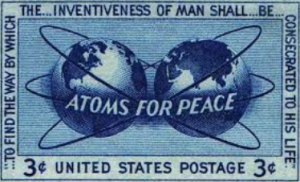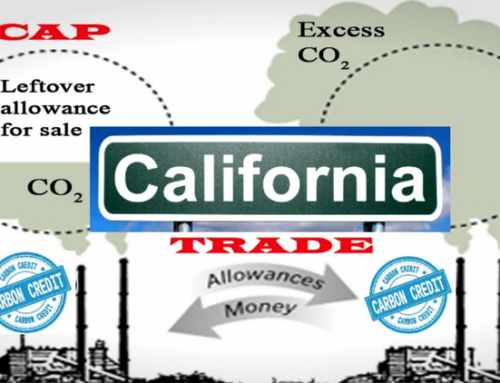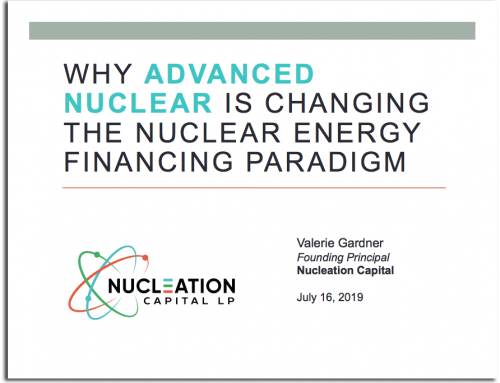
Atoms for Peace: Revisiting the Promise of Nuclear Power on the Cusp of Climate Catastrophe
This is a reprint of the Senior Project submitted to the Division of Social Studies, Bard College
By Amelia Tiemann, May 2019
Preface
When people think about nuclear power, they typically identify with one of two binary positions: either they believe nuclear power is an important part of the solution to climate change, and favor its expansion; or they believe its risks far outweigh any benefits it may provide. Those in the latter group might picture vast areas of uninhabitable land, massive evacuations of people from their homes, or the famous three-eyed fish from The Simpsons. Those in the former might view nuclear power as an often overlooked clean energy source with enormous potential to perform in the midst of uncertain climate conditions, and critical in addressing impending catastrophic consequences of greenhouse gas emissions. Most people who are informed about the issue of climate change can agree that action is needed — at nearly inconceivable scale and speed. Reaching a consensus about the scientifically demonstrated need to rapidly remove carbon emissions from our energy generation took world governments longer than environmental leaders hoped, but eventually happened; now the challenge is tackling the remaining obstacles causing stagnation at global climate negotiations. Our aversion to nuclear power is one of these obstacles; this paper aims to show that including it in energy discussions once again is crucial not only but in our strategies for survival.
Introduction: Climate Change and the Need for Energy Reform
Human reliance on fossil fuels to generate energy allowed modern civilization to flourish beyond previous experience. The Industrial Revolution saw the beginnings of exponential progress in technology that would continue throughout the 20th century. The transition from burning wood for fuel to burning coal, an extremely cheap and abundant source of fuel, allowed large-scale machinery to power factories and provide electricity for cities. Fossil fuels (coal, oil, and natural gas) facilitated substantial and speedy industrial and economic development. In the mid-20th century, however, scientists began to take notice that cheap and abundant energy from fossil fuels came at a price: higher atmospheric concentrations of greenhouse gases led to a warming climate. A few decades later, the scientific community agreed that climate change is likely the single largest existential threat to human beings in history (Rich, 2018). Currently, world governments are confronted with the task of identifying and implementing large-scale energy and technology reform to address carbon emissions. While the modern, industrial world needs scalable, reliable energy to meet the basic livelihood needs of a growing population, climate stability must be a central consideration to ensure the safety of future generations.
Humans have caused more than 1 degree Celsius of warming since the Industrial Revolution from the indiscriminate burning of fossil fuels (Rich, 2018). Current projections from the Intergovernmental Panel on Climate Change (IPCC) estimate that 1.5 degrees Celsius above pre-industrial levels is the upper margin for acceptable warming, before catastrophic effects are predicted to cause irreversible damage to global systems (IPCC Report 2018). If the world is only able to limit warming to 2 degrees Celsius above global average temperatures, climate scientists predict the extinction of the world’s coral reefs and sea level rise of several meters (Rich, 2018). Renowned climate scientist James Hansen describes 2 degrees of warming as “a prescription for long-term disaster” (Hansen, 2009). If emissions patterns remain unchanged and warming exceeds 2 degrees Celsius, dangerous ecological thresholds could be crossed, which would likely cause irreversible acceleration of environmental damage and warming.
These estimates are striking, but not surprising. Most industrialized nations have relied primarily on coal for most of their energy generation for at least a century, which includes electricity, heating, transportation, and other services. United States coal production steadily increased throughout most of the 20th century, peaking in 2006. In 2018, the U.S. relied on coal for 39% of its total energy supply (Energy Information Administration). The electric power sector accounted for over 90% of total coal consumption in 2017 (EIA.gov annual coal report). Natural gas has also supported energy generation in the U.S., and surpassed coal for the first time as the most prevalent fuel for electricity production during 2015 (EIA). Production of coal and natural gas soared in the U.S. in the 20th century because these fuel sources can generate vast amounts of energy at low costs, and can provide electricity at all hours of the day. This constant generation is referred to as base load generation. Base load is the “minimum amount of electric power delivered or required over a given period of time at a steady rate.” In order to generate electricity at the scale required to service the needs of millions of people, not to mention industry infrastructure, power must come from plants that are able to generate the required load on a constant basis. Million of tons of coal and natural gas are burned each day in the U.S. alone to produce baseload electricity that is necessary to power cities, homes, and factories.
Generating base load to power industrialized economies largely from sources that do not emit greenhouse gases would be an important component in combating climate change. In the 1950s, the United States deployed a dispatchable source of energy that could provide just that: nuclear energy, or energy derived from the splitting of the nuclei of atoms of uranium, could provide baseload electricity needs with negligible emissions. Nuclear power plants were particularly advantageous for energy production because they could provide the necessary base load capacity that fossil fuel plants provided, but without the combustion of a fuel source that created pollution. They did not rely on natural conditions to produce energy the way solar and wind generators do, so they could run at all hours of the day. The first nuclear reactor came online in the U.S. in 1957, and delivered as much electricity to the grid as a regular-sized coal plant. The initial deployment rate for U.S. nuclear power in its first two decades was relatively rapid; after this period, however, it stopped. Public fear of nuclear power, which had begun to spread during the environmental movement of the 1970s, accelerated after two major meltdowns occurred, one in the U.S. and one overseas. A wave of protest against nuclear power swept the country, and deployment rates virtually came to a halt.
The nuclear power story is one small part of an evolving climate discourse that has influenced the past several decades of governance. As new scientific findings strengthened the evidence for global warming and the need for emissions reduction, protests from environmental activists in the 1970s pressured politicians to add climate change to their political agendas. Nuclear power had a brief moment of favorability during this period as a symbol of hope for eliminating this new problem. Since then, effective climate policy appears to have reached a standstill. Almost no current climate resolutions are inclusive of nuclear power. The Conference of the Parties to the UNFCCC (COP) meetings have facilitated agreements among world governments for legally binding emissions reduction commitments. The recent Paris Agreement, the result of COP21 in 2015, resolved to pursue a limit of 1.5 degrees Celsius in average global temperatures increase. Most international treaties do not mention nuclear power as part of their proposed energy transition scenario. Meanwhile, climate scientists continue to debate the role nuclear power should play in mitigating the threat of climate change, as valuable time is lost.
This paper postulates that this failure is connected to slowed nuclear power deployment rates. This hypothesis guides the central research question of this thesis, which asks whether overall cost and benefit to human health and safety of nuclear energy relative to the same metrics of not deploying it. Scientists currently agree that negative effects are happening as a direct result of emissions from fossil fuel burning, but current fossil fuel replacement rates in the U.S. and the world are much too low to make a significant contribution to emissions reduction recommendations such as those outlined in the UN SDGs. Despite negotiations, the global energy mix has not become cleaner since 1990. In 2015, 65% of world electricity production came from coal, gas, or oil sources, having increased on average by 0.2% each year since 1995, the year of the first COP (WorldBank). Decreases in U.S. coal-fired generation after peak production in 2006 were met with increasing natural gas production, which caused emissions to drop slightly. Still, natural gas is remains a major source of carbon emissions in the U.S. Total consumption of hydrocarbon energy has grown significantly, and carbon emissions continue to climb every year.
This paper hypothesizes that the reversal in nuclear power learning curves is a crucial yet forgotten piece of this puzzle. Nuclear power was, once, a brand new technology that environmental organizations praised for its ability to mitigate carbon emissions; it is wise to revisit it given the slow pace of current energy reforms in the United States and the world. This question requires critically examining political decision-making not to expand nuclear energy, despite the current environmental reality. A review of the literature suggests that past nuclear accidents, coupled with socio-psychological factors, are responsible for creating entrenched fear and aversion to nuclear power. However, safe operation of nuclear power has proved an effective emissions reduction strategy, which could play a crucial role in climate change reversal if expanded. This paper presents a researched review to identify the origins and causes of continued nuclear fear. A rigorous evaluation of these concerns assesses their validity relative to historical data and projected data, and addresses their significance within the context of the capabilities of nuclear power as one of many climate change mitigation options. Yet unexplained through a purely scientific perspective, this investigation aims to shed light on the social and political reasons that public resistance to nuclear power does not soften, through a multidisciplinary evaluation of costs and benefits associated with nuclear technology.
This thesis does not argue that aversion to nuclear power or arguments against it are irrational. Rather, while nuclear fear results from risk aversion, it has historically played a dominant role in energy discussions, at peril to comprehensive decision-making. The analysis presented in this paper finds that this distinct division in attitudes about energy policy that includes nuclear power stems from an overwhelming sense of fear and disgust among the public, more entrenched and primal than simple disagreement over which is the best technology. Given the severity of the climate crisis, as well as the demonstrated ability of nuclear power to significantly boost carbon-free energy generation, this paper argues that it is crucial to understand and evaluate the technological, environmental, and economic factors involved with nuclear power in order to determine its cost-benefit tradeoff as a carbon-free energy source. Historical analysis helps to pinpoint the origin of nuclear fear, and social psychology sheds light on its propagation in mainstream culture and discourse. The theoretical framework underlying this analysis incorporates elements of political theory, discourse theory, and social psychology in order to impartially evaluate contemporary discourse surrounding nuclear power.
 To continue reading “Atoms for Peace: Revisiting the Promise of Nuclear Power on the Cusp of Climate Catastrophe,” you can click the image on the right to download the 98-page PDF.
To continue reading “Atoms for Peace: Revisiting the Promise of Nuclear Power on the Cusp of Climate Catastrophe,” you can click the image on the right to download the 98-page PDF.
Amelia Tiemann successfully defended her senior project and graduated from Bard College in May, 2019 with a B.A. in Environmental and Urban Studies. She then became a Generation Fellow at the Breakthrough Institute in Oakland, California, where she researched attitudes and shifting public opinion about climate change, showing growing concerns among voters. Even before her graduation, Ms. Tiemann was hired to attend the ninth Clean Energy Ministerial held in Copenhagen in May, 2018, and to report on its proceedings for Terrestrial Energy’s 4th Generation blog. The Clean Energy Ministerial is an annual international forum that brings together governments and other top energy officials committed to accelerating the global clean energy transition. There, Secretary of Energy, Rick Perry, representing the United States Department of Energy, announced the launch of the Nuclear Innovation: Clean Energy Future (NICE Future) initiative, which aims to jumpstart international support for the integration of advanced energy innovation into the global clean energy framework, highlighting the importance of nuclear as a reliable clean energy source. Ms. Tiemann, who previously worked as a nuclear advocacy organizer for Generation Atomic and as as an administrative assistant for Tiemann Investment Advisors, has continued to write for the 4th Generation blog, Lucid Catalyst and will be attending the Environmental Management & Policy program at U.C. Davis in the fall of 2021.









Leave A Comment